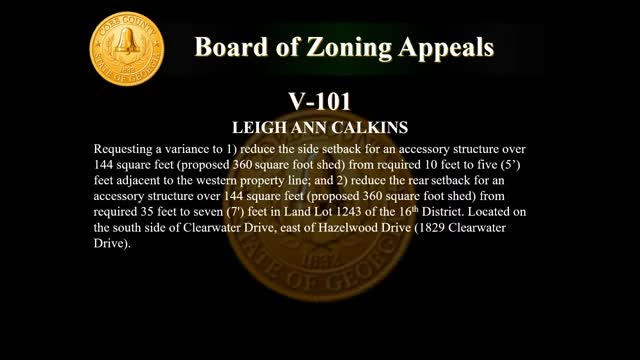Variance Requests Spark Controversy Over Property Setbacks
August 14, 2024 | Cobb County, Georgia
This article was created by AI summarizing key points discussed. AI makes mistakes, so for full details and context, please refer to the video of the full meeting. Please report any errors so we can fix them. Report an error »

In a recent government meeting, several variance requests were discussed, primarily concerning the reduction of setback requirements for accessory structures. The board reviewed multiple cases, with staff recommendations generally favoring approval, provided certain conditions were met.
One notable case involved a request to reduce the side setback for a proposed 360-square-foot shed from 10 feet to 5 feet and the rear setback from 35 feet to 7 feet. The property, located on Clearwater Drive, received no opposition from the public, and the board unanimously supported the staff's recommendation, which included a stipulation against residential or commercial use of the structure.
Another case presented was for a variance to reduce the rear setback from 40 feet to 30 feet for a property on North Elizabeth Lane. Similar to the previous case, there was no public opposition, and the board recommended approval pending a site plan review.
The meeting also addressed a request from Joseph Martin Shea and Susan Carter Shea for a variance to allow a 346-square-foot above-ground pool and a 704-square-foot carport awning, alongside a reduction in setbacks for the carport. Again, the board found no public opposition and recommended approval.
Ivan Meskeman sought a variance to reduce setbacks for a proposed 1,560-square-foot garage, with conditions including no residential or commercial use and restrictions on plumbing and vehicle types stored on-site. The board approved this request, emphasizing the need for the garage's exterior to match the principal building.
In a more contentious case, Michelle Mondragon requested a variance for an existing steel garage built without a permit. The garage's location violated setback requirements, and while the applicant argued for its retention due to financial burdens and neighbor support, concerns were raised about potential commercial use and the number of vehicles stored on the property. The board heard from both the applicant and an opposing neighbor, who expressed worries about the implications of allowing such a structure without strict stipulations. The board ultimately closed the public hearing, indicating further deliberation would be necessary.
Overall, the meeting highlighted the board's commitment to balancing individual property rights with community concerns, as they navigated through various requests for variances while ensuring compliance with zoning regulations.
One notable case involved a request to reduce the side setback for a proposed 360-square-foot shed from 10 feet to 5 feet and the rear setback from 35 feet to 7 feet. The property, located on Clearwater Drive, received no opposition from the public, and the board unanimously supported the staff's recommendation, which included a stipulation against residential or commercial use of the structure.
Another case presented was for a variance to reduce the rear setback from 40 feet to 30 feet for a property on North Elizabeth Lane. Similar to the previous case, there was no public opposition, and the board recommended approval pending a site plan review.
The meeting also addressed a request from Joseph Martin Shea and Susan Carter Shea for a variance to allow a 346-square-foot above-ground pool and a 704-square-foot carport awning, alongside a reduction in setbacks for the carport. Again, the board found no public opposition and recommended approval.
Ivan Meskeman sought a variance to reduce setbacks for a proposed 1,560-square-foot garage, with conditions including no residential or commercial use and restrictions on plumbing and vehicle types stored on-site. The board approved this request, emphasizing the need for the garage's exterior to match the principal building.
In a more contentious case, Michelle Mondragon requested a variance for an existing steel garage built without a permit. The garage's location violated setback requirements, and while the applicant argued for its retention due to financial burdens and neighbor support, concerns were raised about potential commercial use and the number of vehicles stored on the property. The board heard from both the applicant and an opposing neighbor, who expressed worries about the implications of allowing such a structure without strict stipulations. The board ultimately closed the public hearing, indicating further deliberation would be necessary.
Overall, the meeting highlighted the board's commitment to balancing individual property rights with community concerns, as they navigated through various requests for variances while ensuring compliance with zoning regulations.
View full meeting
This article is based on a recent meeting—watch the full video and explore the complete transcript for deeper insights into the discussion.
View full meeting
